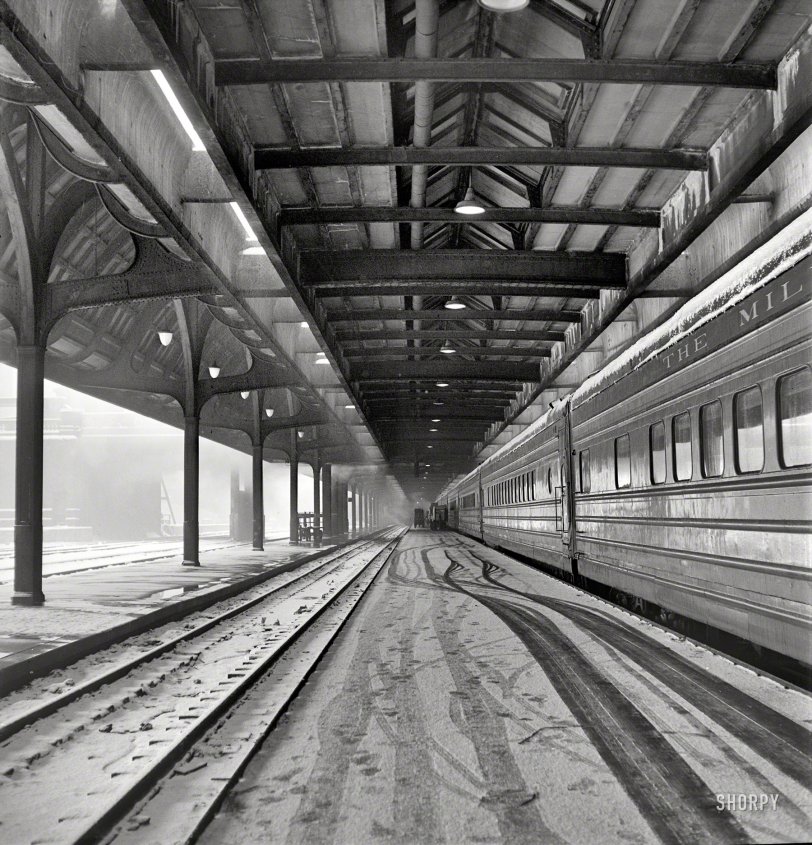


Framed or unframed, desk size to sofa size, printed by us in Arizona and Alabama since 2007. Explore now.
Shorpy is funded by you. Patreon contributors get an ad-free experience.
Learn more.

- Baldwin 62303
- Baldwin VO-1000
- Cold
- No expense spared
- Tough Guys
- Lost in Toyland
- And without gloves
- If I were a blindfolded time traveler
- Smoke Consumer Also Cooks
- Oh that stove!
- Possibly still there?
- What?!?
- $100 Reward
- Freeze Frame
- Texas Flyer wanted
- Just a Year Too Soon
- WWII -- Replacing men with women at the railroad crossing.
- Yes, Icing
- You kids drive me nuts!
- NOT An Easy Job
- I wonder
- Just add window boxes
- Icing Platform?
- Indiana Harbor Belt abides
- Freezing haze
- Corrections (for those who care)
- C&NW at Nelson
- Fallen Flags
- A dangerous job made worse
- Water Stop
Print Emporium
The Milwaukee Road: 1943

January 1943. "A Chicago, Milwaukee, Saint Paul & Pacific Railroad train just arrived at Chicago Union Station." Medium format nitrate negative by Jack Delano for the Office of War Information. View full size.
Mini-Skirts
Only Hiawatha cars built in 1942 were built with skirts, and though they did extend the full length of the cars without cutouts for the trucks or other underbody equipment, they were very short skirts extending down only about 6 inches.
It is possible that wartime shortages of materials caused the design change to add to the cars structural strength.
MILW rib-side cars
These cars haven't had their skirts modified or removed - the MILW's rib-side passenger cars were never fitted with skirts:
Skirts & Ties
Full length skirting on both rail and road cars, like streamlining on steam locomotives, was a maintenance nightmare. It was often modified or removed before everyone got a chance to see it.
Half ties are common when the "ballast" is poured concrete, like in a subway. The gap leaves room for a central drainage gutter. Consult American Railway Engineering Association manuals on line for comments on the practice. The extra labor cost may be saved in the future if the ties don't rot as fast as in ordinary construction.
RE: No center to the ties
From memory, I think railroad tracks on concrete beds don't have full-width ties.
On occasion I walk alongside the Union Station tracks in the Shorpy photo. More often I ride the train from nearby Ogilvie (aka Northwest) station. There are no ties.
Also the Chicago elevated tracks have full-width wood ties, but underground in the subway, with a concrete floor, there are short blocks under each rail like the Shorpy photo.
Full Length Skirting?
The cars have the streamline skirting (rocker panels on automobiles) extending the full length of the carbody. Usually the skirting is eliminated where the trucks are located to permit servicing. I have not seen photos of cars with the full length skirts. Can anyone enlighten?
Missing centers
I have seen this frequently, especially in subway systems such as New York and DC. I expect the cut centers facilitated drainage. Any better ideas out there?
No center to the ties
I am a retired railroader, and I have never seen the centers cut from the ties in a station (like the track to the left). Does anyone know why this was done for sure? It wasn't done to save material as the labor cost would have been twice as much as the material saved.
The vanishing point
Is being carried away in a truck.
Re: Precious memories
kreriver is correct, the Friends of the 261 give everyone the opportunity to enjoy these Milwaukee Road classics. I'm lucky enough to live within earshot of the whistle. http://261.com/
This morning
I just walked through there this morning. It's a lot darker now, because the area around it has been built up and roofed over, but glass-roofed sheds like this are still there, and are still in use for commuter and Amtrak trains. You can see some from the air if you look near Jackson and Canal streets. They appear in films sometimes (Public Enemies was the last one I remember).
Danger Lights!
This location is right where the final scenes of the 1930 film Danger Lights took place which, incidentally, was filmed on the Milwaukee Road as well.
It would have served Mr. Delano well to have loaded some color film in his camera since those Milwaukee Road cars were a bright orange, red and maroon and that would certainly have brightened the mood this gloomy Chicago view.
What a wonderful photograph
This picture just draws you in. In some situations black and white is the only way to go.
Precious memories
The featured train probably had an Otto Kuhler designed “beavertail” observation car on the rear end. It wouldn’t be too many more years before the Brooks Stevens designed Hiawatha observation cars replaced them and were proudly gracing the mains. During the late 70s a lot of the retired passenger cars were rusting away in an area known as the “shops,” in Milwaukee, Wisconsin. Ironically, some of that equipment was birthed (built) in the shops and returned there to die. Fortunately, the Stevens “Cedar Rapids” observation car was rescued and restored. She dances all over the place these days, often pulled by the 4-8-4 Milwaukee steamer 261. I worked in the shops during the late 70s and spent many winter morning exploring that old equipment, including the Cedar Rapids, when my boss needed me to get scarce for a while. Not much I would trade those days for.
























On Shorpy:
Today’s Top 5